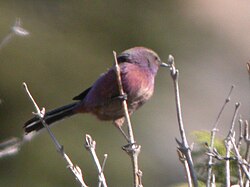| Leptopoecile | |
|---|---|
 | |
| White-browed tit-warbler Leptopoecile sophiae | |
| Scientific classification | |
| Kingdom: | Animalia |
| Phylum: | Chordata |
| Class: | Aves |
| Order: | Passeriformes |
| Family: | Aegithalidae |
| Genus: | Leptopoecile Severtzov, 1873 |
| Type species | |
| Leptopoecile sophiae [1] Severtzov, 1873 | |
Leptopoecile is a genus of birds in the long-tailed tit family Aegithalidae. The genus was once placed in the large family Sylviidae, but analysis of mitochondrial DNA placed it with the long-tailed tits. [2]
The genus contains two species: [3]
| Image | Common name | Scientific name | Distribution |
|---|---|---|---|
 | White-browed tit-warbler | Leptopoecile sophiae | the Himalayas, the Tibetan Plateau, and much of Northwest China. |
| Crested tit-warbler | Leptopoecile elegans | China and possibly India. | |